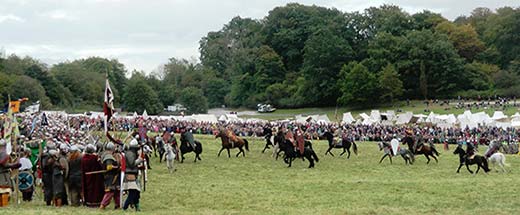History Society Report
The Norman Conquest of Yorkshire:
Speaker: Tuesday, 20 March 2018
Tuesday, 20 March 2018
Our perception of the Norman conquest of England often begins and ends with the Battle of Hastings in 1066, as represented in the famous Bayeux tapestry, soon to make a rare journey to Britain. Dr Paul Dalton, principal lecturer in Medieval History at Canterbury Christ Church University, made a less complicated trip to Hebden Bridge to talk to the local history society about the conquest, and the resistance to Norman rule in Yorkshire in the years that followed that initial significant battle.

The invasion of England by William Duke of Normandy’s army was justified as the rightful overthrow of Harold Godwineson as a perjurer, who had broken the most sacred of oaths of loyalty made to William when he claimed the throne of England for himself. However, establishing Norman rule in England was a much more difficult process than winning the battle which saw the death of Harold. William’s army had to make their way into a resistant London so that he could be crowned in Westminster Abbey as the legitimate Christian King. Opposition there crumbled and William was crowned on Christmas Day 1066.
The process of conquest took far longer. Initially the strength of arms proved at the battles of Hastings and the entry into London allowed William to establish his position as king largely through a mix of force and contract – submission and the taking of hostages followed by promises and marriage deals. However in Yorkshire, at that time part of the entirely distinct and distant earldom of Northumbria, opposition began to grow. William was seen not to have kept his promises, and the imposition of heavy taxes was resented. York itself was described by a contemporary chronicler as being peopled by ‘wild men… seething with discontent’.
William’s method of subduing his kingdom was to build quick and effective motte and bailey castles, topped with wooden palisades, to take control of the surrounding country. In York the remains of two such castles can still be seen, though the stone built Clifford tower is of later date. However, despite this, Yorkshire and Northumbria were not subdued and with the support of the Scottish king and at other times of the Danes, remained at the heart of the struggle against William’s rule.
Eventually William responded with extreme force in what has become known as the harrying of the north, laying waste to the countryside and causing the deaths of perhaps 100,000 as it was recorded that the land ‘north of the Humber was stripped of all means of sustenance’. As a symbol of his success, William made a point of wearing his crown in York at Christmas 1069.
Domesday Book records some of the effects of the harrying of the north, with the value of land in this part of Yorkshire massively reduced and with large areas described as waste, or without value. The change in society was profound, for while the daily lives of the peasantry probably remained largely unchanged, the Anglo-Saxon aristocracy was crushed and became largely invisible. Norman French lords were rewarded with lands, and the government and religion of England, while retaining some of the same structures and institutions, was entirely in the hands of the Norman aristocracy. In later years there was a revival of Yorkshire monasticism with the foundation of French orders and the building of abbeys bringing to England beautiful Romanesque architecture, still evident in a place like Selby Abbey.
The next talk to the Local History Society will be at Hebden Bridge Methodist Church on Wednesday 28th March at 7.30, when Dr Nigel Smith with deliver the Alan Petford Memorial Lecture on Township Boundaries and Commons Disputes in the South Pennines. Everyone is welcome. There will be an additional talk on Wednesday April 18th when Nick Wilding will repeat his talk Seven Centuries of Recorded Floods in the Calder Valley which so many people had to miss because of the snow.
With thanks to Sheila Graham for this report
Details of all the Society’s activities can be found on the website and you can also follow them on their Facebook page.
See also


